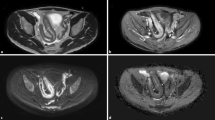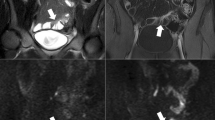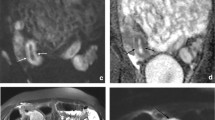Abstract
Background
MR enterography is increasingly utilized for noninvasive evaluation of disease activity in young patients with Crohn disease and has great impact on clinical management. Diffusion-weighted imaging (DWI) is a rapid MR imaging technique that measures molecular diffusion of water and is sensitive to the inflammatory process; however, its value to MR enterography has not been rigorously evaluated.
Objective
To determine whether the addition of DWI to MR enterography is helpful in evaluating Crohn disease activity in young patients when compared to a histological reference.
Materials and methods
In this single-institution retrospective study, we searched an imaging database for the period January 2010 to December 2012 to identify patients age 19 years and younger who had MR enterography with diffusion-weighted imaging (DWI). We used an electronic medical record search to identify those who had MR enterography and colonoscopy performed within 28 days of each other. All MR enterography scans were performed on a 1.5-T or 3-T clinical MR scanner with phased-array torso coil configuration using standard pulse sequences as well as axial DWI with b values of 50, 400 and 800. Bowel segments were evaluated for disease activity based on standard MR enterography sequences; in addition, segmental apparent diffusion coefficient (ADC) values were calculated based on DWI. Histological reference for disease activity was based on assessment for mucosal inflammatory changes on endoscopic biopsy. MR enterography and DWI evaluation were performed in a blinded fashion with respect to histological results.
Results
We included imaging of 78 bowel segments from 27 patients (mean age 14.5 ± 3.02 years) with known Crohn disease in the study. The mean ADC for bowel segments with active disease was 1.56 ± 0.7 × 103 mm2/s compared with 2.58 ± 1.4 × 103 mm2/s for segments without active disease, a difference that was statistically significant (P < 0.01, Student’s t-test). Using a threshold value of 2.0 × 103 mm2/s, DWI demonstrated lower accuracy (64.1%) but higher sensitivity (78.8%) for detecting active disease compared with standard MR enterography (69.2% and 54.6%, respectively). Combining DWI with MR enterography, using DWI as the initial screen and MR enterography afterward to reduce false negativity, led to a significant increase in accuracy (76.9%; P = 0.03, McNemar’s test) compared with either imaging technique alone.
Conclusion
Although DWI does not perform as well as standard MR enterography for detection of active Crohn disease, the combination of DWI and MR enterography increases imaging accuracy for determining disease activity compared with either technique alone. These results indicate that DWI adds value to MR enterography and supports the incorporation of DWI into MR enterography protocols for evaluation of Crohn disease in young patients.




Similar content being viewed by others
References
Silverstein J, Grand D, Kawatu D et al (2012) Feasibility of using MR enterography for the assessment of terminal ileitis and inflammatory activity in children with Crohn disease. J Pediatr Gastroenterol Nutr 55:173–177
Darge K, Anupindi SA, Jaramillo D (2008) MR imaging of the bowel: pediatric applications. Magn Reson Imaging Clin N Am 16:467–478
Gee MS, Nimkin K, Hsu M et al (2011) Prospective evaluation of MR enterography as the primary imaging modality for pediatric Crohn disease assessment. AJR Am J Roentgenol 197:224–231
Mollard BJ, Smith EA, Dillman JR (2015) Pediatric MR enterography: technique and approach to interpretation — how we do it. Radiology 274:29–43
Brenner DJ (2008) Should computed tomography be the modality of choice for imaging Crohn’s disease in children? The radiation risk perspective. Gut 57:1489–1490
Smith EA, Dillman JR, Adler J et al (2012) MR enterography of extraluminal manifestations of inflammatory bowel disease in children and adolescents: moving beyond the bowel wall. AJR Am J Roentgenol 198:W38–W45
Leyendecker JR, Bloomfeld RS, DiSantis DJ et al (2009) MR enterography in the management of patients with Crohn disease. Radiographics 29:1827–1846
Feng S-T, Law MW-M, Huang B et al (2010) Radiation dose and cancer risk from pediatric CT examinations on 64-slice CT: a phantom study. Eur J Radiol 76:e19–e23
Goske MJ, Applegate KE, Boylan J et al (2008) The ‘Image Gently’ campaign: increasing CT radiation dose awareness through a national education and awareness program. Pediatr Radiol 38:265–269
Qayyum A (2009) Diffusion-weighted imaging in the abdomen and pelvis: concepts and applications. Radiographics 29:1797–1810
Oto A, Kayhan A, Williams JTB et al (2011) Active Crohn’s disease in the small bowel: evaluation by diffusion weighted imaging and quantitative dynamic contrast enhanced MR imaging. J Magn Reson Imaging 33:615–624
Oto A, Zhu F, Kulkarni K et al (2009) Evaluation of diffusion-weighted MR imaging for detection of bowel inflammation in patients with Crohn’s disease. Acad Radiol 16:597–603
Ream JM, Dillman JR, Adler J et al (2013) MRI diffusion-weighted imaging (DWI) in pediatric small bowel Crohn disease: correlation with MRI findings of active bowel wall inflammation. Pediatr Radiol 43:1077–1085
Sempere GAJ, Martinez Sanjuan V, Medina Chulia E et al (2005) MRI evaluation of inflammatory activity in Crohn’s disease. AJR Am J Roentgenol 184:1829–1835
Florie J, Wasser MNJM, Arts-Cieslik K et al (2006) Dynamic contrast-enhanced MRI of the bowel wall for assessment of disease activity in Crohn’s disease. AJR Am J Roentgenol 186:1384–1392
Darbari A, Sena L, Argani P et al (2004) Gadolinium-enhanced magnetic resonance imaging: a useful radiological tool in diagnosing pediatric IBD. Inflamm Bowel Dis 10:67–72
Alexopoulou E, Roma E, Loggitsi D et al (2009) Magnetic resonance imaging of the small bowel in children with idiopathic inflammatory bowel disease: evaluation of disease activity. Pediatr Radiol 39:791–797
Tolan DJM, Greenhalgh R, Zealley IA et al (2010) MR enterographic manifestations of small bowel Crohn disease. Radiographics 30:367–384
Oto A, Fan X, Mustafi D et al (2009) Quantitative analysis of dynamic contrast enhanced MRI for assessment of bowel inflammation in Crohn’s disease. Acad Radiol 16:1223–1230
Moore WA, Khatri G, Madhuranthakam AJ et al (2014) Added value of diffusion-weighted acquisitions in MRI of the abdomen and pelvis. AJR Am J Roentgenol 202:995–1006
Kiryu S, Dodanuki K, Takao H et al (2009) Free-breathing diffusion-weighted imaging for the assessment of inflammatory activity in Crohn’s disease. J Magn Reson Imaging 29:880–886
Freiman M, Perez-Rossello JM, Callahan MJ et al (2013) Characterization of fast and slow diffusion from diffusion-weighted MRI of pediatric Crohn’s disease. J Magn Reson Imaging 37:156–163
Neubauer H, Pabst T, Dick A et al (2013) Small-bowel MRI in children and young adults with Crohn disease: retrospective head-to-head comparison of contrast-enhanced and diffusion-weighted MRI. Pediatr Radiol 43:103–114
Sohn B, Kim M-J, Koh H et al (2014) Intestinal lesions in pediatric Crohn disease: comparative detectability among pulse sequences at MR enterography. Pediatr Radiol 44:821–830
Oto A, Schmid-Tannwald C, Agrawal G et al (2011) Diffusion-weighted MR imaging of abdominopelvic abscesses. Emerg Radiol 18:515–524
Schmid-Tannwald C, Agrawal G, Dahi F et al (2012) Diffusion-weighted MRI: role in detecting abdominopelvic internal fistulas and sinus tracts. J Magn Reson Imaging 35:125–131
Yoshizako T, Wada A, Takahara T et al (2012) Diffusion-weighted MRI for evaluating perianal fistula activity: feasibility study. Eur J Radiol 81:2049–2053
Bozgeyik Z, Ozgocmen S, Kocakoc E (2008) Role of diffusion-weighted MRI in the detection of early active sacroiliitis. AJR Am J Roentgenol 191:980–986
Fefferman DS, Farrell RJ (2005) Endoscopy in inflammatory bowel disease: indications, surveillance, and use in clinical practice. Clin Gastroenterol Hepatol Off Clin Pract J Am Gastroenterol Assoc 3:11–24
Hordonneau C, Buisson A, Scanzi J et al (2014) Diffusion-weighted magnetic resonance imaging in ileocolonic Crohn’s disease: validation of quantitative index of activity. Am J Gastroenterol 109:89–98
Conflicts of interest
None
Author information
Authors and Affiliations
Corresponding author
Rights and permissions
About this article
Cite this article
Shenoy-Bhangle, A.S., Nimkin, K., Aranson, T. et al. Value of diffusion-weighted imaging when added to magnetic resonance enterographic evaluation of Crohn disease in children. Pediatr Radiol 46, 34–42 (2016). https://doi.org/10.1007/s00247-015-3438-1
Received:
Revised:
Accepted:
Published:
Issue Date:
DOI: https://doi.org/10.1007/s00247-015-3438-1




